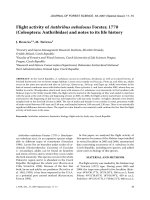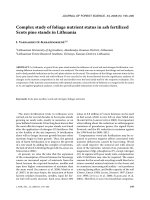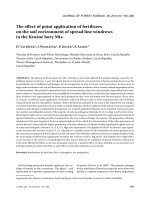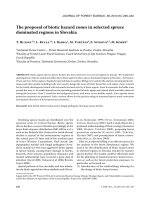Báo cáo lâm nghiệp: "Automatic determination of fiber orientation on OSB surface using line detection method based on small eigenvalue analysis" doc
Bạn đang xem bản rút gọn của tài liệu. Xem và tải ngay bản đầy đủ của tài liệu tại đây (655.43 KB, 6 trang )
385
Ann. For. Sci. 62 (2005) 385–390
© INRA, EDP Sciences, 2005
DOI: 10.1051/forest:2005034
Original article
Automatic determination of fiber orientation on OSB surface using
line detection method based on small eigenvalue analysis
Chuanshuang HU
a
, Chiaki TANAKA
b
*, Reynolds OKAI
c
, Tadashi OHTANI
d
a
College of Forest, South China Agricultural University, Wushan, Tianhe District, Guangzhou, Guangdong, P.R. of China
b
Department of Environmental Science and Technology, Kagoshima University, Kagoshima, Japan
c
Department of Technology Education, University of Education, Winneba, Kumasi Campus, PO Box 1277, Kumasi, Ghana
d
Faculty of Science and Engineering, Shimane University, Matsue, Shimane, Japan
(Received 22 March 2004; accepted 22 February 2005)
Abstract – The modulus of rupture (MOR) which is the key to the strength of oriented strand board (OSB) depends on the fiber orientation on
OSB surface. In order to improve the quality of OSB products, it is essential to optimize the flake alignments of the wood strands. In this paper,
a line detection method based on small eigenvalue in conjunction with Canny edge detector was adopted to simulate the fiber strands with the
ultimate aim of optimizing the fiber orientation and quality of the manufactured product. Then ellipse fitting analysis and/or line fitting analysis
were used to determine the fiber orientation for all line or ellipse connectedness labeling, which expresses the fiber strands. The fiber orientation
measured automatically was compared to that measured manually. It was observed that the ratio of the fiber orientation measured manually to
that measured automatically was close to unity. The results indicated that the method developed in this paper when used to determine fiber
orientation of the face surface in OSB was effective. However, the method developed in this paper was not effective for the under surface
because small strands tend to fall when the face and middle layer were distributed, on the edge formation of fiber strands.
orientated strand boards / fiber orientation / image analysis
Résumé – Détermination automatique de l’orientation des fibres à la surface d’un panneau OSB au moyen d’une méthode de détection
basée sur l’analyse des petites valeurs propres. Le module de rupture (MOR), facteur clé de la résistance des panneaux à lamelles orientées
(OSB), dépend de l’orientation des fibres à la surface du panneau. Afin d’améliorer la qualité des produits OSB, il est essentiel d’optimiser
l’arrangement des lamelles. Dans ce papier, une méthode de détection de contour basée sur l’analyse des petites valeurs propres, en association
avec la méthode de détecteur de Canny, a été adoptée pour simuler les lamelles, avec comme objectif final d’optimiser l’orientation des fibres
et la qualité du produit fini. Ensuite une analyse par identification d’une ligne ou d’une ellipse a été utilisée pour déterminer l’orientation des
fibres pour toute connectivité identifiée, correspondant aux lamelles. L’orientation des fibres mesurée automatiquement a été comparée à celle
mesurée manuellement. On a observé que le rapport entre les deux était proche de l’unité. Ces résultats montrent que la méthode développée
dans cet article est efficace pour déterminer l’orientation des fibres sur la face d’un panneau OSB. Cependant, elle ne l’est pas pour déterminer
l’orientation des fibres en dessous de la surface car de petites lamelles tendent à se placer sur les bords quand les couches extérieures et centrales
ont des orientations distribuées dans leur plan.
panneau à lamelles orientées / orientation des fibres / analyse d’image
1. INTRODUCTION
Some wood species have received little attention in terms of
usage because of their perceived poor physical and mechanical
properties. An engineered wood has almost uniform physical
and mechanical properties compared to conventional wood.
Besides, there is a remarkable improvement in the mechanical
properties of engineered wood products. Thus engineered
wood products like OSB could promote the use of species with
low mechanical properties. Now the use of OSB is gaining
increasing popularity in Europe, North America and Asia. It has
been established that the density of wood based panels has a
direct impact on properties, such as stiffness and strength [5].
However, the amount and condition of the raw material in the
mat, together with the pressing conditions, determine the aver-
age resultant density of wood based materials. It has also been
established that density variations in both the horizontal and
vertical planes of wood based panel products inevitably occurs.
The vertical density distribution from a higher density at the
surface to a lower density in the core is found to depend on the
pressing conditions and extent of resin cure [4, 8]. On the other
hand, the horizontal density distribution is attributed to the mat
formation process and layout of the wood strands [2].
OSB comprises large size element which are wood strand,
and its mechanical properties depend on the fiber orientation
of the strands such as MOR, which is the key to the strength of
* Corresponding author:
Article published by EDP Sciences and available at or />386 C.S. Hu et al.
OSB in bending. In order to improve the quality of OSB prod-
ucts, it is essential to optimize the arrangement or fiber orien-
tation of the wood strands. Pinto et al. (2003) have shown that
image processing technology is useful in the application of
wood products [7]. Nishimura et al. conducted studies on the
relationship between the surface strands and MOR by applying
the technique of image analysis (IA) [6]. In this paper, a novel
image processing method based on line detection analysis was
proposed to automatically detect fiber orientation on OSB sur-
face with the ultimate aim at optimizing the fiber orientation.
2. MATERIALS AND METHODS
The materials selected for the experiment were commercial OSB
imported from Germany of 1800 mm × 900 mm × 9 mm. The wood
specie is pine (Pinus sylvestris L.). The schematic diagram of the
detecting system for the wood strand arrangement or fiber orientation
is shown in Figure 1. It consists of a CCD camera (Charge Coupled
Device) of the type (Victor KY-F350, Victor JVC), two flood lamps
(Toshiba reflector 150WF), a CNC (Computer Numerical Control)
working table (Funuc M180 series), and the host computer whose soft-
ware system was developed and installed by authors. Samples were
placed on the 2-dimensional CNC working table and illuminated by
two flood lamps from two sides. By adjusting the height and the focus
of the digital camera, images of the wood strands were captured under
80 dpi and they were 24-BPP (bit per pixel) gray images. The com-
puter program was written in MatLab Release 12 as code resource. The
flow chart of the program is shown in Figure 2.
3. IMAGE PROCESSING ALGORITHM
After capturing and inputting the image g, Canny edge detec-
tor, which was proposed by Canny et al. [1], was operated on
it. The Canny method finds edges by looking for local maxima
of the gradient of g. The gradient is calculated using the deriv-
ative of a Gaussian filter. The method uses two thresholds, to
detect strong and weak edges, and includes the weak edges in
the output only if they are connected to strong edges. It can be
described as follows.
(1) Repeat steps (2) till (6) for ascending values of the standard
deviation.
(2) Convolve an image g with a Gaussian filter of standard
deviation σ .
(3) Estimate local edge normal directions n using the following
equation for each pixel in the image:
.(1)
Figure 1. The schematic diagram of the system.
Figure 2. The flow chart of the computer program.
n
∇ Gg×()
∇ Gg×()
=
Determination of OSB fiber orientation 387
(4) Find the location of the edges using the following equation
for non-maximal suppression:
.(2)
(5) Compute the magnitude of the edge using the following
equation:
|G
n
× g| = | (G × g)|. (3)
(6) Threshold edges in the image with hysteresis (low and high
thresholds) to eliminate spurious response.
There are three parameters for Canny edge detector: standard
deviation (Sigma), low threshold, and high threshold. Here we
determined the three parameters to be 1.2, 0.05, and 0.2, respec-
tively. After Canny edge detector, the output image called edge
image was obtained. Then a novel line detector based on small
eigenvalue analysis, which was detailed by Guru et al. [3], was
developed and operated. It can be described as follows: Let
ge(M, N) be an edge image gotten after canny edge detector.
Let p
i
(i = 1, 2, , n) be the edge pixels and n be the total number
of edge pixels in ge. Let W be a window of size k × k for some
odd integer k > 1 used for mask processing. The mask window
is placed at an edge pixel p
i
. All edge pixels connected to p
i
and
converted by the mask window W is defined to be F
i
, the family
set for p
i
. The small eigenvalue λ
i
of F
i
is computed as follows:
(4)
(5)
(6)
(7)
(8)
(9)
where x
i
and y
i
are the X and Y coordinates of the point p
i
(x
i
,
y
i
) inside F
i
; m is the total number of edge pixels inside F
i
. The
mask processing was operated from the bottom left corner to
the right up corner. As the successive windows overlap each
other, it is common that there are some pixels that are members
of more than one family. It is obvious that if an edge pixel only
belongs to one family, the pixel is a spurious edge pixel, i.e.,
it is eliminated as a noise edge pixel. Research results reported
that the smaller the eigenvalue of the covariance matrix of con-
nected pixels, the stronger is the evidence that those connected
pixels form a linear segment [9]. So if an edge pixel belongs
to two or more families, the minimum eigenvalue of families
is decided to be the final response value for that pixel. So the
proposed transformation function T: ge (an edge image) gs
(small eigenvalue image) is defined as follows.
if g
e
(x, y) is an edge pixel and
g
e
(x, y) is not a noise pixel otherwise. (10)
The image called small eigenvalue image is then passed for-
ward to a thresholding operation. If a pixel g
e
(x, y) is less than
a predefined threshold, it is said to be a linear edge pixel and
be set a value 1. If not, then the pixel g
e
(x, y) is set a value 0.
This binary image is the desired image consisting of only linear
edge pixels. This procedure can be expressed as follows:
(11)
Then the component connected labeling described by Haralick
and Shapiro [4] was used to locate the linear segments on the
output image from the line detector based on small eigenvalue
analysis. Finally, all linear segments that were detected by com-
ponent connectedness labeling were passed forward to the lin-
ear regression analysis described as follows:
.
(12)
And the fiber orientation of the individual fiber can be
described as follows:
.(13)
Then the fiber orientation distribution was computed and the
orientation of an OSB was defined as the main peak of the dis-
tribution.
4. RESULTS AND DISCUSSION
The original pictures of the top surface and undersurface are
shown in Figures 3a and 4a. It can be seen that the flake align-
ment on the top surface is very clear whereas the flake align-
ment on the undersurface is blurred because there are many
small strands, which contort the edge lines of strands.
Nishimura et al. [6] reported that small strands fell when the
above multilayer mats were distributed automatically. The final
image processed pictures of the top surface and undersurface
are shown in Figures 3b and 4b. The fiber strands are expressed
well using the edge lines detected by line detector on the top
surface. However, there are some false edge lines because of
∂
2
∂n
2
Gg× 0=
∇
C
x
1
m
x
i
i 1=
m
∑
=
C
y
1
m
y
i
i 1=
m
∑
=
C
11
1
m
x
i
2
c
x
2
–
i 1=
m
∑
=
C
22
1
m
y
i
2
c
y
2
–
∑
=
C
12
C
21
1
m
x
i
y
i
c
x
c
y
–
i 1=
m
∑
==
λ
1
2
c
11
c
22
c
11
c
22
–()
2
2 c
12
2
c
21
2
+()+–+
=
→
g
s
xy,()Tg
e
xy,()[] =
min λ
i
g
e
xy,()F
i
j∀ 12 n,, ,=∈{}()
∞
=
gd x y,()τg
s
xy,()[] ()=
1 if min λ
i
g
e
xy,()F
i
j∀ 12 n,, ,=∈{}()t<
0 otherwise
=
2
11 11
22
11
()
nn nn
ii iii
ii ii
nn
ii
ii
yx xxy
k
nx x
== ==
==
−
=
−
∑∑ ∑∑
∑∑
(arctan( ))abs k
θ
=
388 C.S. Hu et al.
the effect of small strands on the edge lines. Canny edge detec-
tor and a line detector based on small eigenvalue analysis were
used to detect the strands’ edge lines. There are three parame-
ters for Canny edge detector (High threshold, Low threshold,
and standard deviation) and one parameter for the line detector
based on small eigenvalue (threshold t). The final image proc-
essed pictures shown in Figure 4b were gotten when three
parameters of Canny edge detector were 0.05, 0.2, and 1.5,
respectively, and the threshold parameter of line detector was
0.17625. This parameter set has a fine performance on the top
surface. It is expected that an optimum set of parameters can
be achieved to improve the performance of detecting the edge
lines after many trials.
The connectedness component labeling was also operated to
search for the line objects. Every labeled object was forwarded
to least line fitting and/or ellipse fitting to determine the fiber
orientation after connectedness component labeling. The rec-
tangle fitting and ellipse fitting analysis based on separating the
whole picture into certain numbers of subsets using a window
size M × N were used by Nishimura et al. [6]. However, the cap-
tured objects inside a window are often fractures of several
components. Since the chance to capture full information,
which belongs to a single object inside a window, is very slim,
the fiber orientation determined by ellipse or rectangle fitting
analysis based on a window is not correct. The method pro-
posed in this paper was to try to capture the whole object indi-
vidually. Then the captured information which belongs to a
single object was forwarded to a line fitting and/or ellipse fit-
ting. The histograms of the fiber orientation on the top and
under surfaces shown in Figures 3b and 4b are shown in
Figures 5 and 6, respectively. The angle distribution of the top
surface is a normal distribution. The central angle of the dom-
inant peak bar is around 23.3 degrees. However, there was no
dominant peak, and the frequency distribution of the angles was
almost constant in the range 0 to 80 degrees for the undersur-
face. As described above, the small strands blurred the edge
lines of the undersurface because the conveyer movement and
vibration worked like a filter to cause the small strands to align
random. Most of the small strands fall and collect on the surface
of a conveyer, which forms the undersurface of the finished
OSB production. Although the big strands have a clear align-
ment on this surface according to the design product line, the
small strands are randomly distributed. This is the reason why
there is no dominant bar in the angle distribution. The param-
eters or other methods should be considered to eliminate the
effect of small strands on the edge maps.
A test experiment was conducted to test the robust and effec-
tiveness of the system to determine the fiber orientation. Small
samples of 300 × 75 × 11 mm
3
were cut from a big OSB. The
longitudinal direction of the big OSB was defined as a baseline.
Figure 3. The original picture and the final image processed picture
on the top surface. a: Original picture; b: final image processed pic-
ture.
Figure 4. The original picture and the final image processed picture
on the undersurface. a: Original picture; b: final image processed pic-
ture.
Determination of OSB fiber orientation 389
The acute angle between the longitudinal direction of a small
sample and the baseline initially fixed by the authors was varied
from 0 to 90 degrees with increment of 15 degrees. Six small
samples were obtained for every acute angle. Then the pictures
of all small samples were taken and processed by the method
developed in this paper. The central and mean angles of histo-
grams for every rotating position are shown in Figure 7. There
are two types of angles: mean angle and central angle, which
can be used to express the main stream of the flake alignment
on the surface of OSB. As shown in Figure 7, it is much better
to use the central angle instead of the mean angle to express the
fiber orientation. So we propose that when evaluating the qual-
ity of OSB, the central angle should be used.
The fiber orientation measured manually and automatically
by the method proposed in this paper is shown in Figure 8. It
can be observed that the angle measured automatically (Aa) is
close to the angle measured manually (Am). The ratio of Aa/
Am is also shown in Figure 8. The ratio varies in the range 0.95
to 1.1. The two angles are so close that it is reliable to say that
the method developed in this paper to determine the fiber ori-
entation is suitable.
The ultimate aim of automatically determining the fiber ori-
entation in OSB is to control the flake alignment in the practical
production line so that the quality of OSB can be optimized.
Here we just developed an automatic method to determine the
fiber orientation on OSB under experimental conditions. But
it is expected to apply the algorithm on a flake alignment picture
of a distributing mat, which can be taken by a high speed video
camera. This topic will be studied later.
5. CONCLUSIONS
We developed an automatic system to determine the fiber
orientation on the surface of OSB using a novel line detector
based on small eigenvalue analysis in conjunction with Canny
edge detector. The results have shown that the image analyzing
system is effective and suitable to determine the fiber orienta-
tion on the top surface of OSB. The measured fiber orientation
using the method developed in this paper is very close to that
measured manually. The central angle of the histogram is much
Figure 6. The angle distribution histogramz of the undersurface. Cen-
tral angle is the angle at the middle position of a bar in histogram.
Figure 5. The angle distribution histogram of the top surface. Central
angle is the angle at the middle position of a bar in histogram.
Figure 8. Comparison of automatically and manually measured
angles. Aa: the angle measured automatically; Am: the angle measu-
red manually.
Figure 7. The automatically measured angles at different rotating
angles.
390 C.S. Hu et al.
more effective than the mean angle. It is expected that the deter-
mined fiber orientation can be used to optimize the strands dis-
tribution and the quality control of OSB in the longitudinal
direction when the properties in the perpendicular directions
are not critical.
However, it is still necessary to do some experiments to opti-
mize the image processing parameters. Also an on-line quality
control system will be developed based on on-line monitoring
fiber orientation to optimize the flake alignment and the
mechanical properties of OSB.
REFERENCES
[1] Canny A., A computational approach to edge detection, IEEE
Trans. PAMI, 8 (1986) 769–698.
[2] Dai C., Steiner R., On horizontal density variation in randomly-for-
med short fiber wood composite boards, Composites, Part A, 28
(1997) 57–64.
[3] Guru D.S., Shekar B.H., Nagabhushan P., A simple and robust line
detection algorithm based on small eigenvalue analysis, Pattern
Recognition Lett. 25 (2004) 1–13.
[4] Haralick R.M., Shapiro L.G., Computer and robot vision, Vol. 1,
University of Washinton, Addison-Wesley Pub. Co. 1992.
[5] Kelly M., Critical review of the relationship between processing
parameters and physical properties of particleboard, General Tech.
Rep. FPL-10, US FPL, Madison, WI, p. 65.
[6] Nishimura T., Ansell M.P., Ando N., The relationship between the
arrangement of wood strands at the surface of OSB and the modulus
of rupture determined by image analysis, Wood Sci. Technol. 35
(2001) 555–562.
[7] Pinto I., Pereira H., Usennius A., Analysis of log shape and internal
knots in twenty maritime pine (Pinus pinaster Ait.) stems based on
visual scanning and computer aided reconstruction, Ann. For. Sci.
60 (2003) 137–144.
[8] Suchsland O., Behavior of a particleboard mat during the press
cycle, For. Prod. J. 17 (1969) 51–57.
[9] Tsai D.M., Hou H.T., Su H.J., Boundary-based corner detection
using eigenvalues of covariance matrices, Pattern Recognition Lett.
20 (1999) 31–40.
To access this journal online:
www.edpsciences.org









